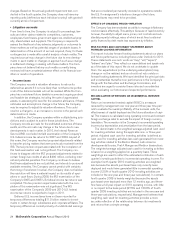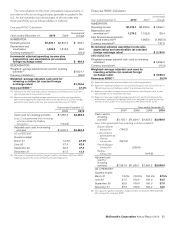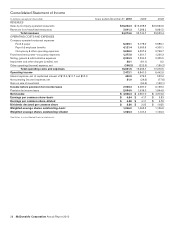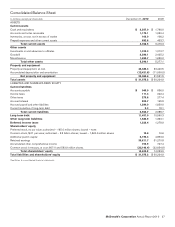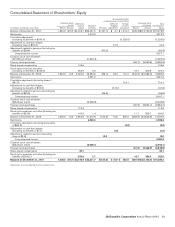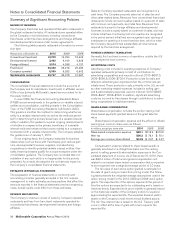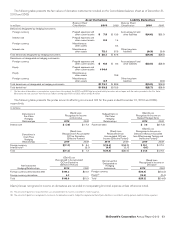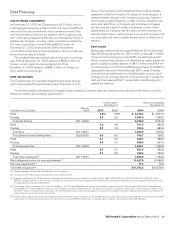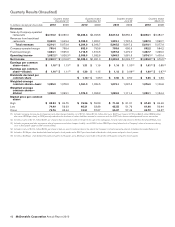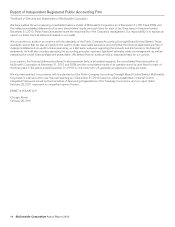McDonalds 2010 Annual Report Download - page 36
Download and view the complete annual report
Please find page 36 of the 2010 McDonalds annual report below. You can navigate through the pages in the report by either clicking on the pages listed below, or by using the keyword search tool below to find specific information within the annual report.• Fair Value Hedging Strategy
The Company enters into fair value hedges to reduce the
exposure to changes in the fair values of certain liabilities. The
fair value hedges the Company enters into consist of interest rate
exchange agreements which convert a portion of its fixed-rate
debt into floating-rate debt. All of the Company’s interest rate
exchange agreements meet the shortcut method requirements.
Accordingly, changes in the fair values of the interest rate
exchange agreements are exactly offset by changes in the fair
value of the underlying debt. No ineffectiveness has been
recorded to net income related to interest rate exchange agree-
ments designated as fair value hedges for the year ended
December 31, 2010. A total of $2.3 billion of the Company’s
outstanding fixed-rate debt was effectively converted to floating-
rate debt resulting from the use of interest rate exchange
agreements.
• Cash Flow Hedging Strategy
The Company enters into cash flow hedges to reduce the
exposure to variability in certain expected future cash flows. The
types of cash flow hedges the Company enters into include
interest rate exchange agreements, forward foreign currency
exchange agreements and foreign currency options.
To protect against the reduction in value of forecasted foreign
currency cash flows (such as royalties denominated in foreign
currencies), the Company uses forward foreign currency
exchange agreements and foreign currency options to hedge a
portion of anticipated exposures.
When the U.S. dollar strengthens against foreign currencies,
the decline in present value of future foreign denominated royal-
ties is offset by gains in the fair value of the forward foreign
currency exchange agreements and/or foreign currency options.
Conversely, when the U.S. dollar weakens, the increase in the
present value of future foreign denominated royalties is offset by
losses in the fair value of the forward foreign currency exchange
agreements and/or foreign currency options.
Although the fair value changes in the foreign currency
options may fluctuate over the period of the contract, the
Company’s total loss on a foreign currency option is limited to the
upfront premium paid for the contract. However, the potential
gains on a foreign currency option are unlimited as the settle-
ment value of the contract is based upon the difference between
the exchange rate at inception of the contract and the spot
exchange rate at maturity. In limited situations, the Company uses
foreign currency option collars, which limit the potential gains and
lower the upfront premium paid, to protect against currency
movements.
The hedges typically cover the next 12-15 months for certain
exposures and are denominated in various currencies. As of
December 31, 2010, the Company had derivatives outstanding
with an equivalent notional amount of $434.4 million that were
used to hedge a portion of forecasted foreign currency denomi-
nated royalties.
The Company excludes the time value of foreign currency
options, as well as the discount or premium points on forward
foreign currency exchange agreements, from its effectiveness
assessment on its cash flow hedges. As a result, changes in the
fair value of the derivatives due to these components, as well as
the ineffectiveness of the hedges, are recognized in earnings
currently. The effective portion of the gains or losses on the
derivatives is reported in the deferred hedging adjustment
component of OCI in shareholders’ equity and reclassified into
earnings in the same period or periods in which the hedged
transaction affects earnings.
The Company recorded after tax adjustments related to cash
flow hedges to the deferred hedging adjustment component of
accumulated OCI in shareholders’ equity. The Company recorded
a net decrease of $1.5 million and $31.5 million for the years
ended December 31, 2010 and 2009, respectively. Based on
interest rates and foreign currency exchange rates at
December 31, 2010, no significant amount of the $15.0 million
in cumulative deferred hedging gains, after tax, at December 31,
2010, will be recognized in earnings over the next 12 months as
the underlying hedged transactions are realized.
• Hedge of Net Investment in Foreign Operations
Strategy
The Company primarily uses foreign currency denominated debt
to hedge its investments in certain foreign subsidiaries and affili-
ates. Realized and unrealized translation adjustments from these
hedges are included in shareholders’ equity in the foreign cur-
rency translation component of OCI and offset translation
adjustments on the underlying net assets of foreign subsidiaries
and affiliates, which also are recorded in OCI. As of
December 31, 2010, a total of $3.5 billion of the Company’s
outstanding foreign currency denominated debt was designated
to hedge investments in certain foreign subsidiaries and affiliates.
• Credit Risk
The Company is exposed to credit-related losses in the event of
non-performance by the counterparties to its hedging instru-
ments. The counterparties to these agreements consist of a
diverse group of financial institutions. The Company continually
monitors its positions and the credit ratings of its counterparties
and adjusts positions as appropriate. The Company did not have
significant exposure to any individual counterparty at
December 31, 2010 and has master agreements that contain
netting arrangements. Some of these agreements also require
each party to post collateral if credit ratings fall below, or
aggregate exposures exceed, certain contractual limits. At
December 31, 2010, neither the Company nor its counterparties
were required to post collateral on any derivative position, other
than on hedges of certain of the Company’s supplemental benefit
plan liabilities where its counterparties were required to post col-
lateral on their liability positions.
INCOME TAX UNCERTAINTIES
The Company, like other multi-national companies, is regularly
audited by federal, state and foreign tax authorities, and tax
assessments may arise several years after tax returns have been
filed. Accordingly, tax liabilities are recorded when, in
management’s judgment, a tax position does not meet the more
34 McDonald’s Corporation Annual Report 2010


